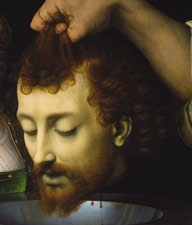New Connections appear every Wednesday. Sign up for a reminder.
 1280852
1280852 12801001
12801001 5301024
5301024 5861024
5861024 4851024
4851024 8011024
8011024 8261024
8261024 7441024
7441024 6821024
6821024 7041024
7041024 7871024
7871024 7371024
7371024 8911024
8911024 6401024
6401024 8401024
8401024 8581024
8581024 8741024
8741024 8471024
8471024 1280983
1280983 7371024
7371024 8941024
8941024 7451024
7451024 7991024
7991024 12711024
12711024 1280852
1280852
I'm Irina Shifrin, and I work in human resources, and my topic is opera.
There are very few moments in our life that make you feel that
it's a big moment. And you can get spoiled and that's how opera makes me feel.
In the midst of our busy week
it's a celebration. It's music
it's acting, it's costume, it's scenery, it's poetry. And above all, it's the operatic human voice.
Carmen was a breakthrough for me. All of the sudden it all came together, and there was no acting, there was no theater. There was frighteningly real, raw emotion.
This painting makes me think about Carmen. The way she entered with a stared defiance, old and mysterious like a sphinx. And one cannot really get Carmen
without Manet, that colorful, intense, sensual, a little bit violent culture. When I look at the matador I think, "This is Escamillio," and he could have just step off Carmen's set.
Each time La Traviata's main character, a famous courtesan, Violetta, dies, for a moment the world seems such a dull and lifeless place. This statue reconciles me to Violetta's death. If she didn't die that's how she would look. And that's probably why composers and librettists love to kill their leading characters while they're still young and beautiful.
I associate Monteverdi's Orpheo with this statue. Orpheus is leading Eurydice from the underworld. He's not supposed to look at her.
And it's very dramatic, it's very uncertain. And he is asking, "who will assure me that she follows me?" She's also confused why Orpheus is not looking at her. Doesn't he love her anymore?
When I look at this kimono and its bewitching beauty I think about Madame Butterfly and Pinkerton, who is in love with her, even though he might injure her butterfly wings. I think exactly the same thoughts. I must have it!
Regnault's Salomé is triumphant, happy, careless. It's just the wind. It's just the caprice.
Solario's painting, she seem to be so unemotional. In the opera
she's all about emotion. She's bored, she doesn't know what she wants, and she's in pain.
She's ready to pay with her life for getting her desires fulfilled.
Robert le Diable is considered to be one of the first grand operas, that would have four or five acts, huge casts
and very lavish, splendid productions. Today even largest opera houses simply cannot afford this kind of expensive production.
You can imagine how taxing it must be on a singer, not to mention
the audience, to sit through four or five acts. There's a whole range of psychology that studies
the psychology of happiness. One of the theories is that the only time when we are happy is when we are in the flow.
When you lose track of time. When you forget about the problems of your life.
Being in the opera, listening to the human operatic voice, gets me into the flow, and
that's when I'm happy.
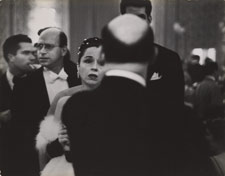 |
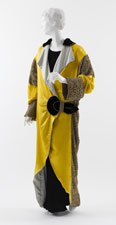 |
 |
 |
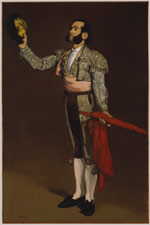 |
 |
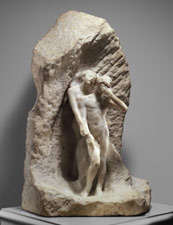 |
 |
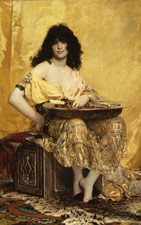 |
 |
 |
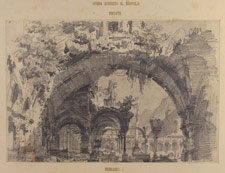 |
 |
 |
 |
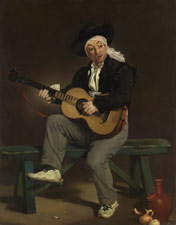 |
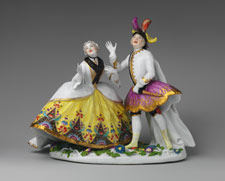 |
Works of art in order of appearanceLast Updated: June 22, 2015. Not all works of art in the Museum's collection may be on view on a particular day. For the most accurate location information, please check this page on the day of your visit. |
||
 |
Opening Night, Metropolitan Opera 1955 Garry Winogrand (American) Gelatin silver print Gift of John Korman, 1992 (1992.5031) © The Estate of Garry Winogrand, courtesy Fraenkel Gallery, San Francisco More information: The Collection Online Not on view
|
 PhotographsSecond Floor
PhotographsSecond Floor |
 |
Opera coat 1912 Paul Poiret (French) Yellow and pale blue silk satin, black silk velvet, turquoise silk satin with gold and silver filé crocheted overlay, and silver filé trapunto half-belt and trim Purchase, Irene Lewisohn Bequest, 1982 (1982.350.2) More information: The Collection Online Not on view
|
 The Costume InstituteFirst Floor
The Costume InstituteFirst Floor |
 |
Mezzetin ca. 1718–20 Jean Antoine Watteau (French) Oil on canvas Munsey Fund, 1934 (34.138) More information: The Collection Online Not on view
|
 European PaintingsSecond Floor
European PaintingsSecond Floor |
 |
The Spanish Gypsy 1912 Robert Henri (American) Oil on canvas Arthur Hoppock Hearn Fund, 1914 (14.80) More information: The Collection Online Not on view
|
 American Paintings and SculptureFirst and Second Floors
American Paintings and SculptureFirst and Second Floors |
 |
A Matador 1866–67 Édouard Manet (French) Oil on canvas Signed (lower left): Manet H. O. Havemeyer Collection, Bequest of Mrs. H. O. Havemeyer, 1929 (29.100.52) More information: The Collection Online Not on view
|
 European PaintingsSecond Floor
European PaintingsSecond Floor |
 |
The Old Courtesan modeled 1887, this bronze cast 1910 Auguste Rodin (French) Bronze Gift of Thomas F. Ryan, 1910 (11.173.3) More information: The Collection Online Not on view
|
 European Sculpture and Decorative ArtsSecond Floor
European Sculpture and Decorative ArtsSecond Floor |
 |
Orpheus and Eurydice probably modeled before 1887, executed 1893 Auguste Rodin (French) Marble Gift of Thomas F. Ryan, 1910 (10.63.2) More information: The Collection Online Not on view
|
 European Sculpture and Decorative ArtsSecond Floor
European Sculpture and Decorative ArtsSecond Floor |
 |
Kimono with carp, water lilies, and morning glories Meiji period, ca. 1876 Japan Resist-dyed, painted, and embroidered silk gauze (ro) Gift of Naoki Nomura, 2006 (2006.73.2) More information: The Collection Online Not on view
|
 Asian ArtSecond Floor
Asian ArtSecond Floor |
 |
Salomé 1870 Henri Regnault (French) Oil on canvas Signed, dated, and inscribed (left center): HRegnault [initials in monogram] / Rome 1870 Gift of George F. Baker, 1916 (16.95) More information: The Collection Online Not on view
|
 European PaintingsSecond Floor
European PaintingsSecond Floor |
 |
Salome with the Head of Saint John the Baptist probably ca. 1506–7 Andrea Solario (Italian) Oil on wood The Friedsam Collection, Bequest of Michael Friedsam, 1931 (32.100.81) More information: The Collection Online Not on view
|
 European PaintingsSecond Floor
European PaintingsSecond Floor |
 |
The Ballet from Robert le Diable 1871 Edgar Degas (French) Oil on canvas Signed and dated (lower right): Degas / 1872 H. O. Havemeyer Collection, Bequest of Mrs. H. O. Havemeyer, 1929 (29.100.552) More information: The Collection Online Not on view
|
 European PaintingsSecond Floor
European PaintingsSecond Floor |
 |
Architectural Ruins with a View of a Garden; Stage design for Giacomo Meyerbeer's opera, "Robert le diable" 19th century Carlo Ferrario (Italian) Graphite; partly squared in graphite The Elisha Whittelsey Collection, The Elisha Whittelsey Fund, 1962 (62.570.22) More information: The Collection Online Not on view
|
 Drawings and PrintsSecond Floor
Drawings and PrintsSecond Floor |
 |
Louis Gueymard (1822–1880) as Robert le Diable 1857 Gustave Courbet (French) Oil on canvas Signed (lower left): G. Courbet. Gift of Elizabeth Milbank Anderson, 1919 (19.84) More information: The Collection Online Not on view
|
 European PaintingsSecond Floor
European PaintingsSecond Floor |
 |
A Theater Audience 19th century Honoré Daumier (French) Pen and black ink, gouache, and watercolor over black chalk Bequest of Walter C. Baker, 1971 (1972.118.203) More information: The Collection Online Not on view
|
 Drawings and PrintsSecond Floor
Drawings and PrintsSecond Floor |
 |
Pierrot Laughing 1855 Nadar (Gaspard-Félix Tournachon) (French); Adrien Tournachon (French) Coated salted paper print from glass negative Purchase, The Horace W. Goldsmith Foundation Gift through Joyce and Robert Menschel, 1998 (1998.57) More information: The Collection Online Not on view
|
 PhotographsSecond Floor
PhotographsSecond Floor |
 |
The Spanish Singer 1860 Édouard Manet (French) Oil on canvas Signed and dated (right, on bench): ed. Manet 1860 Gift of William Church Osborn, 1949 (49.58.2) More information: The Collection Online Not on view
|
 European PaintingsSecond Floor
European PaintingsSecond Floor |
 |
Two Opera Singers 1749–50 Johann Joachim Kändler (German) after a composition by Charles-Nicholas Cochin le Jeune (French); Meissen Manufactory (German) Hard-paste porcelain Gift of Irwin Untermyer, 1964 (64.101.56) More information: The Collection Online Not on view
|
 European Sculpture and Decorative ArtsFirst Floor
European Sculpture and Decorative ArtsFirst Floor |
© 2011 The Metropolitan Museum of Art |
||






